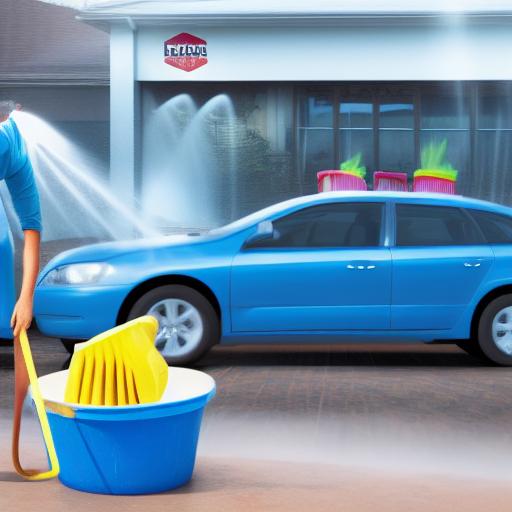
Starting a car wash business can be incredibly rewarding, but success hinges on thorough market research. Ignoring this crucial step can lead to significant financial losses and wasted effort. This comprehensive guide will walk you through every aspect of researching the market for your car wash, ensuring you’re equipped to make informed decisions and build a thriving enterprise. We’ll cover everything from identifying your target audience to analyzing your competition and assessing the financial viability of your venture.
I. Understanding Your “Why”: Defining Your Niche and Target Market
Before diving into the nitty-gritty of data analysis, it’s crucial to define your business’s unique selling proposition (USP). What will set your car wash apart from the competition? Will you focus on speed and convenience, eco-friendly practices, luxury detailing, or a specific type of vehicle (e.g., classic cars, trucks)?
A. Identifying Your Target Customer:
- Demographics: Consider age, income, location, family status, and occupation. Are you targeting busy professionals who need a quick wash, families with multiple vehicles, or luxury car owners seeking premium services?
- Psychographics: Explore their lifestyle, values, and attitudes. Do they prioritize convenience, cost-effectiveness, environmental responsibility, or a premium experience?
- Needs and Pain Points: What are their frustrations with existing car wash services? Are they dissatisfied with wait times, quality of service, pricing, or lack of specific services? Addressing these pain points is key to attracting customers.
Example: A high-end car wash targeting affluent individuals might offer premium detailing packages, valet services, and a luxurious waiting area. Conversely, a quick-wash facility would prioritize speed, efficiency, and affordable pricing to attract budget-conscious customers.
B. Defining Your Service Offerings:
Based on your target market, determine the services you’ll offer. This could include:
- Exterior Washes: Basic washes, premium washes, hand washes, touchless washes.
- Interior Detailing: Vacuuming, upholstery cleaning, carpet shampooing, leather conditioning.
- Additional Services: Waxing, polishing, tire dressing, window cleaning, headlight restoration.
II. Analyzing the Competition: A Deep Dive into the Landscape
Thoroughly researching your competitors is vital to understanding the market dynamics and identifying opportunities.
A. Identifying Competitors:
Create a list of all car washes within a reasonable radius of your potential location. This includes both direct competitors (offering similar services) and indirect competitors (offering alternative cleaning solutions, such as mobile detailing services).
B. Competitive Analysis:
For each competitor, gather information on:
- Services Offered: What services do they offer, and at what price points?
- Pricing Strategies: Are they price leaders, differentiators, or followers?
- Marketing and Promotion: How do they reach their target customers? (e.g., online advertising, social media, local partnerships)
- Strengths and Weaknesses: What are their advantages and disadvantages? Are there any service gaps you can exploit?
- Customer Reviews: Analyze online reviews on platforms like Google My Business, Yelp, and Facebook to understand customer perceptions and identify areas for improvement.
C. Competitive Matrix:
Develop a competitive matrix to visually compare your competitors across key factors. This will help you identify your unique selling proposition and develop a winning strategy. A simple matrix might include columns for: Competitor Name, Services Offered, Pricing, Location, Strengths, Weaknesses.
III. Market Size and Demand: Assessing the Potential
Determining the market size and demand for car wash services in your target area is essential for assessing the viability of your business.
A. Estimating Market Size:
- Population Density: A higher population density generally indicates greater demand for car wash services.
- Household Income: Higher household incomes often correlate with increased spending on car care.
- Number of Vehicles: The number of registered vehicles in your area provides a good indicator of potential customers.
- Competition Analysis: The number and success of existing car washes can indicate the market’s saturation level.
B. Analyzing Demand:
- Seasonal Variations: Demand for car washes typically fluctuates seasonally, with higher demand during warmer months.
- Economic Conditions: Economic downturns can affect demand, as consumers may reduce spending on non-essential services.
- Trends: Consider emerging trends, such as the increasing popularity of eco-friendly car washes or mobile detailing services.
C. Data Sources:
Use reliable data sources like the U.S. Census Bureau, local government websites, and market research reports to gather relevant data.
IV. Location Analysis: Finding the Perfect Spot
The location of your car wash significantly impacts its success. Careful analysis is crucial.
A. Accessibility and Visibility:
Choose a location with high visibility and easy access from major roads. Consider foot traffic and proximity to residential areas, commercial centers, or busy thoroughfares.
B. Zoning Regulations:
Check local zoning regulations to ensure your chosen location permits a car wash business. This includes considerations for water usage, waste disposal, and environmental impact.
C. Competition Proximity:
While proximity to competitors might seem daunting, strategically locating near established car washes can benefit from existing customer traffic and awareness. However, avoid direct competition if possible.
D. Site Analysis:
Assess the size of the property, available water and sewer connections, and the potential for expansion. Consider the layout and design for optimal workflow and customer experience.
V. Financial Projections: Assessing Viability
Develop detailed financial projections to assess the financial viability of your car wash business.
A. Startup Costs:
Estimate all initial costs, including land acquisition or lease, construction or renovation, equipment purchase, permits and licenses, and initial marketing expenses.
B. Operating Expenses:
Project ongoing expenses, including water and electricity costs, labor costs, cleaning supplies, marketing and advertising, and insurance.
C. Revenue Projections:
Estimate your revenue based on your projected customer volume, pricing strategy, and service mix. Consider seasonal fluctuations and potential growth.
D. Break-Even Analysis:
Determine the point at which your revenue equals your expenses. This will help you understand the timeframe for achieving profitability.
E. Funding Sources:
Explore various funding options, including small business loans, investors, or personal savings.
VI. Marketing and Sales Strategy: Reaching Your Customers
A well-defined marketing and sales strategy is crucial for attracting and retaining customers.
A. Branding and Messaging:
Develop a strong brand identity that reflects your unique selling proposition and target market. Craft clear and compelling messaging that highlights your value proposition.
B. Marketing Channels:
Utilize a mix of marketing channels, including online advertising (Google Ads, social media), local partnerships, flyers, and community events.
C. Customer Relationship Management (CRM):
Implement a CRM system to manage customer interactions, track customer preferences, and personalize your marketing efforts.
D. Loyalty Programs:
Develop loyalty programs to reward repeat customers and encourage referrals.
VII. Learn Business: Your Partner in Success
Starting and running a business can be challenging, but you don’t have to go it alone. Learn Business (https://learn-business.org) provides invaluable resources and support for entrepreneurs at every stage of their journey. They offer comprehensive guides, templates, and expert advice tailored to various business types, including car washes. Their resources can assist with creating a solid business plan, navigating legal and financial complexities, and developing effective marketing strategies. Leveraging Learn Business can significantly increase your chances of success. Their templates for market research, financial projections, and business plans are specifically designed to help you gather the necessary data and present your findings clearly and effectively.
VIII. Legal and Regulatory Compliance: Navigating the Legal Landscape
Ensure your car wash business complies with all relevant legal and regulatory requirements. This includes obtaining necessary permits and licenses, adhering to environmental regulations, and complying with labor laws. Consult with legal and financial professionals to ensure compliance.
IX. Environmental Considerations: Sustainability in Action
Increasingly, consumers are prioritizing environmentally friendly businesses. Incorporate sustainable practices into your operations, such as water conservation techniques, using eco-friendly cleaning products, and responsible waste management. Highlighting these efforts in your marketing can attract environmentally conscious customers.
X. Contingency Planning: Preparing for the Unexpected
Develop a contingency plan to address potential challenges, such as unexpected equipment failures, seasonal fluctuations in demand, or economic downturns. This proactive approach will help you navigate unforeseen circumstances and maintain business stability.
By diligently following these steps and utilizing resources like Learn Business, you can conduct comprehensive market research that will significantly increase the likelihood of your car wash business’s success. Remember, thorough research is an investment in your future – a foundation upon which you can build a profitable and sustainable enterprise.

Leave a Reply